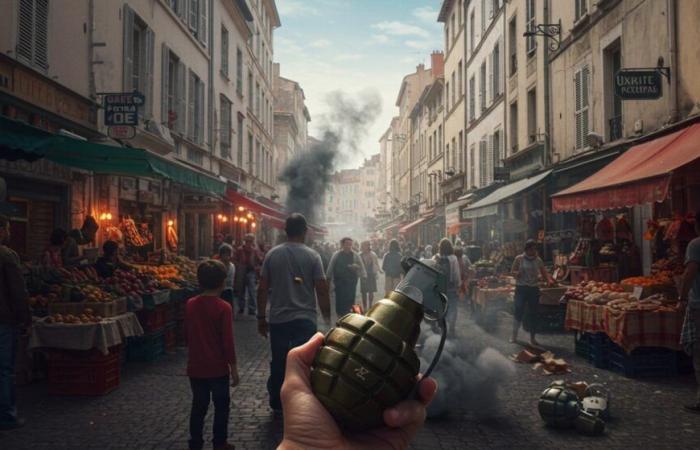A 12 -year -old child injured by a plaster pomegranate bought € 1 in Sète. How does an object sold as a toy caused such a drama? Read to understand …
Imagine a sunny Sunday morning, an animated crowd strolling through the colorful aisles of a flea market. Among the stalls, a 12 -year -old child, intrigued, buys for 1 euro what he thinks is a toy. But what seemed to be an innocent babiole turns out to be a plaster grenade, a potentially dangerous object. The incident, which occurred on May 4, 2025 in Sète, Hérault, rocked the community and relaunched the debate on the security of objects sold on the markets. How could such a drama have happened? Let’s dive into this disturbing affair.
An incident that reveals safety flaws
The Sète flea market, known for its friendly atmosphere and unusual finds, was the scene of an unexpected event. A 12 -year -old boy, accompanied by his mother, bought an object that he believed to be a toy. According to witnesses, the child manipulated the object, pulling on a wire, causing a violent explosion. Fortunately, injuries have remained minor, but the incident raises crucial issues about market sales regulations.
Plaster grenades, often used for military training, contain a low dose of explosive that projects plaster when activated. Although their power is limited, they can cause damage, especially in hands, eyes or face. In this specific case, the child was reached by plaster bursts, requiring immediate medical care.
“The blast was so sudden that everyone jumped. We don’t expect that in a market! »»
A witness present on site
What exactly happened?
Around 11 a.m., the firefighters were alerted to rescue the child, sounded by the explosion. The plaster projections touched him with hands, eyes and belly. Transported to hospital for in -depth exams, the young boy got out of it with light injuriesbut the incident could have had much more serious consequences. His mother, present at the time of the facts, was deeply shocked.
The seller, a 59 -year -old man, said he thought he was selling a harmless toy. According to the chief of the municipal police, the child confirmed that he had bought the object for only 1 euro. This tragic mistake highlights a lack of vigilance, both from the seller and buyers, faced with potentially dangerous objects.
Standing fact: The sale of plaster grenades is strictly prohibited to the public, because they are reserved for military use. Their presence on a market is therefore illegal.
Plaster grenades: an unknown danger
Plaster grenades, although less powerful than military explosives, are not toys. Their mechanism is based on a small explosive load which, once triggered, releases fragments of plaster. These objects, often confused with gadgets or game accessories, can cause injuries, especially when manipulated by children.
In France, their sale is regulated, and their use is limited to specific training, especially in the army. However, similar cases have already been reported. For example, a teenager lost one hand by manipulating explosive substances in another region. These incidents recall that the public security must be reinforced in the face of the circulation of dangerous objects.
Why do these objects end up on markets? Several factors can explain it:
- Ignorance : Sellers often ignore the real nature of the objects they offer.
- Lack of controls : Flea markets, although supervised, do not always benefit from rigorous inspections.
- Request for unusual objects : Buyers are attracted to original items, without always checking their danger.
Market security in question
The flea markets, popular with their authenticity and diversity, are places where we find everything: vintage clothes, trinkets, old tools … But this freedom of exchange can sometimes be a problem. Sète’s incident highlights the need for Reinforced controls To guarantee the safety of visitors, especially children.
In many cities, market organizers collaborate with the authorities to perform inspections. However, the informal nature of certain stalls makes this task complex. Occasional sellers, who sell personal objects, are not always aware of the risks they run.
“We often buy on a crush, without thinking that it can be dangerous. This incident must make us think. »»
-A chips used to flea markets
To prevent such dramas from reproducing, several measures could be envisaged:
- Awareness of sellers : Inform about prohibited or dangerous objects.
- Regular inspections : Strengthen local authorities controls.
- Clear : Set up signs recalling the safety rules.
An incident that marks spirits
Sète’s incident is not an isolated case, but he shocked by his suddenness and context. A market, supposed to be a place of conviviality, has turned into a preventable accident. This event recalls that vigilance is in order, even in familiar environments.
For residents of Sète, this incident could change the perception of local markets. Families, in particular, could hesitate to let their children handle objects sold at low prices. Confidence, essential to the atmosphere of the markets, risks being shaken if concrete measures are not taken.
| Aspect | Issue | Proposed solution |
|---|---|---|
| Sale of objects | Unidentified dangerous objects | Training of sellers |
| Checks | Insufficient inspections | Regular patrols |
| Awareness | Lack of information | Display campaigns |
Towards stricter regulations?
The sale of objects such as plaster grenades is liable to legal proceedings, because it contravenes the laws on explosives. In the case of Sète, the seller could face sanctions, although his ignorance seems to have played a role. This incident could encourage the authorities to tighten the rules supervising the flea markets.
In other countries, as in the United Kingdom, strict regulations force sellers to declare the nature of the objects they offer. In France, although laws exist, their application remains unequal, especially in informal markets. Harmonization of practices could reduce risks.
The local authorities of Sète have already announced a strengthening of markets on the markets. This measure, although late, shows an awareness of the issues. It remains to be seen whether it will be sufficient to reassure the population.
The role of parents and buyers
If sellers and organizers have a responsibility, buyers are not to be outdone. Parents, in particular, must redouble vigilance in the face of objects sold at low prices. A 1 euro toy may seem trivial, but this incident proves that it can hide unsuspected dangers.
Some simple reflexes can make the difference:
- Check the origin of the objects before purchase.
- Avoid dubious or not labeled articles.
- Supervise children during purchases.
These gestures, although basic, can prevent accidents. Responsible consumer education is also essential to prevent such dramas from reproducing.
A call for collective vigilance
Sète’s incident is not only the story of an isolated error. It reflects systemic flaws in market management and the circulation of dangerous objects. In order for the markets to remain places of pleasure and discovery, a collective action is necessary.
Authorities, sellers, buyers and even visitors have a role to play. By strengthening controls, raising public awareness and adopting responsible behavior, it is possible to prevent new incidents. Security should not be luxury, but priority.
“The markets are the heart of our cities. Let’s protect them by being more vigilant. »»
A local market organizer
In conclusion, the explosion of a plaster pomegranate in Sète is a brutal reminder that even the most familiar places can hide dangers. This incident, although without serious consequences, must serve as a lesson. By drawing the teachings of this case, we can make our markets safer and preserve their unique charm. Vigilance is the price of serenity.








